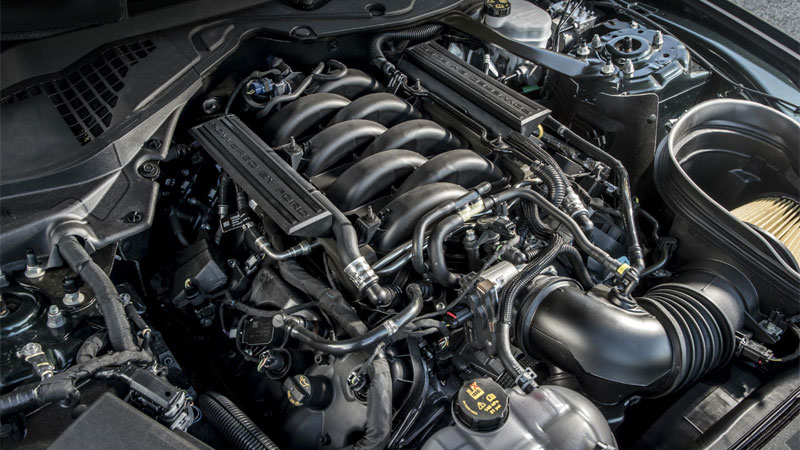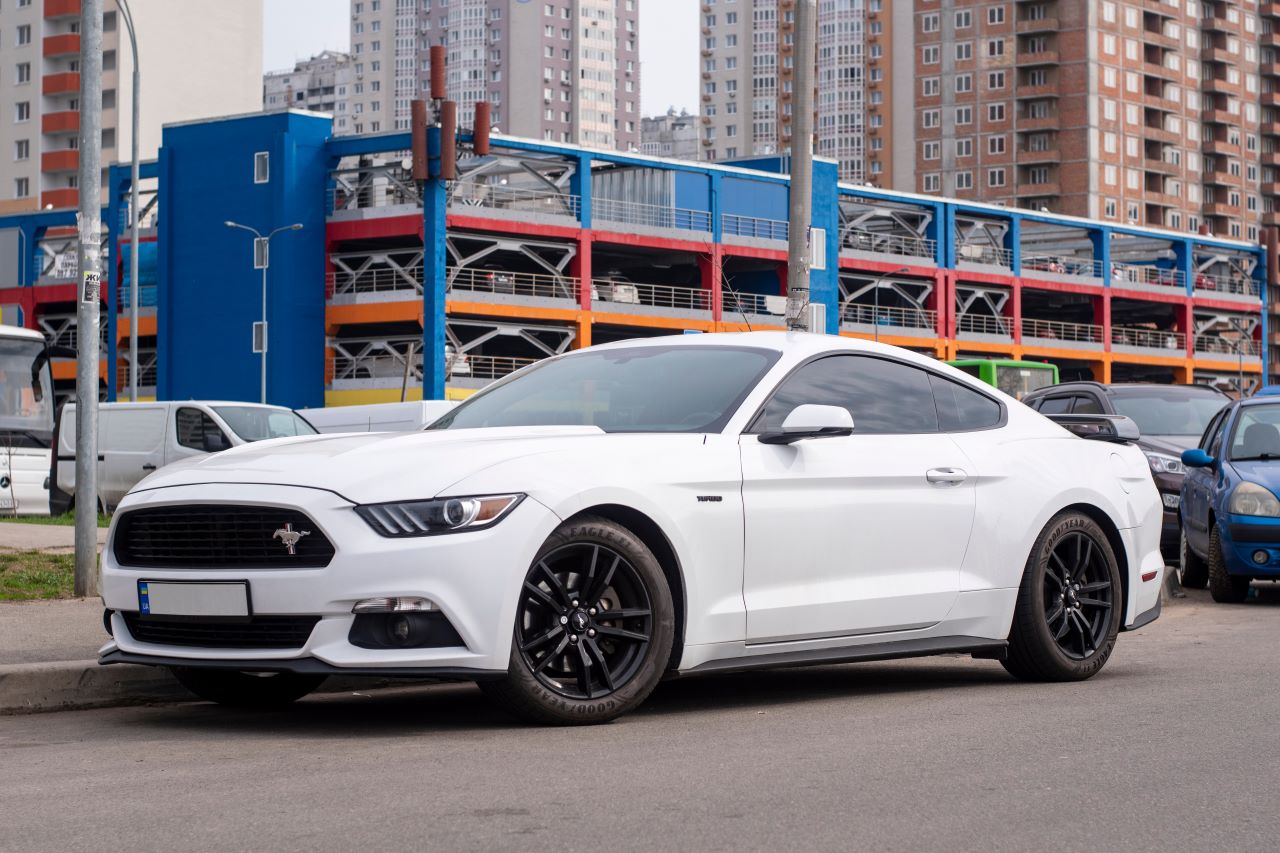When the 5.0 Coyote engine was designed it was manufactured with a new cylinder head. This first-generation Coyote engine was made from 2011 through 2014.
It was used in Mustang GT and F-150 pickup trucks. As for performance, the intake and exhaust lobes of the camshaft moved in unison, so it was limited in power and efficiency.
The newly remodeled cylinder head was necessary to give the engine the versatility and performance it needed. It was the first new overhead camshaft cylinder head since the 4.6-liter V8.
One of the key differences in the two generations of the Coyote engine was Twin Independent Variable Cam Timing (Ti-VCT).
-
The Ford Mustang with the 5.0-liter Coyote V8 engine.
Here’s How the New Coyote Engine Design Enhanced Performance.
According to MotorTrend.com, the first generation Coyote engines had a basic port fuel injection design, similar to modular engines. The manifold was made from light materials to keep the weight level down and absorb heat. The first-generation engines ran at 420 horsepower at 6,500 rpm.
When the company switched to the Ti-VCT it changed the engine platform. From 2015 through 2017, upgrades were focused on airflow and higher rpm. This new Coyote engine featured larger intake and exhaust valves.
The VCT system was rebuilt to limit camshaft movement and to improve cold-start emissions. The pistons had larger valves as well. Several other minor upgrades improved performance.
The biggest upgrade occurred in 2015 with the addition of charge motion control valves, which were highly advanced over the previous system. It resulted in a better air/fuel combination that offered improved fuel economy and lower emissions.
The second-generation Coyote engine saw horsepower go up to 435 at 6,500 rpm. Torque output increased from 390 to 400 pound-feet, at 4,250 rpm.
The third-generation (2018-2023) Coyote engines produced 460 horsepower and 420 pound-feet at the same 4,250 rpm.
For the 2024 Mustang, Ford is reporting that 67% of new orders are equipped with the all-new fourth-gen Coyote engine with its 480 horsepower and 415 pound-feet of torque.
See Also – 7 Symptoms of a Faulty Camshaft Position Sensor
Issues With the 5.0 Coyote Engine
No engine is perfect, and the same can be said for Ford engines. According to VehicleHistory.com, here are some of the common issues found in the Ford 5.0 Coyote engine when turbocharged or super-boosted.
- Oil leaks
- Ignition coil failure
- Bad or oil-covered spark plugs
- Issues with the exhaust gas circulation valve
- Problems with electronic throttle
- Vehicles were built without roll pins
- Transmission issues are common such as slips, rough shifting, and clunks
- Rough Idling
Even though the engine isn’t perfect, fixing any issues the Coyote engine may have is an easy process.
See Also – 4 Symptoms of Bad Engine Mounts
5.0 Coyote Engine Specs
For all the “gear heads” out there, here are the specs for the 5.0 Coyote engine:
- Manufacturer: the Ford Engine Plant in Windsor, Ontario
- Production: the engine was made from 2011 through the present
- Cylinder block and head: aluminum
- Fuel: Gasoline
- Fuel system: generation 1 5. Coyote engines (2011 – 2017) sequential multi-port fuel system. 2018 through the present, combined direct and port injection.
- Configuration and cylinders: V, and 8
- Valves: 4 per cylinder
- Valvetrain: DOHC
- Power/hp: 360-460 hp
- Torque: 380-420 ft-lb/3,850-4,500
- Engine weight: 445 lbs
- Firing order: 1,5,4,8,6,3,7,2
- Engine oil used: SAE 5W-20
- Used in: Ford Mustang GT, Ford F-150, Ford Falcon GT, and other vehicles
See Also – How Much Does a Muffler Delete Cost?
Verdict: Reliable
While there may be some issues with these Ford engines, overall the 5.0 Coyote engine is reliable and performs well. If there are issues, they are usually easy to fix.
- The History of the BMW M Coupe (the “Clown Shoe”) - Mar 26, 2024
- The History of the Ford Flex - Feb 28, 2024
- Can You Trade In a Car With Body Damage or Mechanical Issues? - Feb 21, 2024



Why my engine 5.0 in my F150 2019 it’s too loud ??
The Coyote engine does not have an EGR valve and no Coyote engine did not have independent variable valve timing. It was one of the features at introduction in 2010. In fact the independent intake and exhausy variable cam timing is exactly why they were able to skip the EGR system, it does so by retarding the exhaust at the correct time tremendously reducing nitrogen dioxide output with no EGR.
On third motor in my 18 f150.. waiting on a motor which are on backorder. Imo these motors are junk.. no oil on driver side heads.. total engine failure!
A few things that I have learned about coyote are that they suffer from oil starvation. First mod after CAI should be oil catch cans on both sides. For whatever reason a CAI on these motors results in instant oil blow by. If you’re not great at keeping your eye on oil consumption, pull the motor and build it the way it should have been built. With a normal coyote, Ford didn’t really go the extra mile on bearings, rods and pistons, springs, valves, and valve train. Under most usage though, should be fine. Start running it harder and doing odds and end modifications which impact air volume in/out, then you better start watching oil consumption. If you don’t, bye bye bearings.
If you’ve gone through 3 motors you need to start looking at WHY. These are reliable motors, common to see at 850-900 WHEEL hp with boost on E85 with only internal modification required to do that being a $200 set of OPG’s. Aside from the motor itself, causing the motors to go bad. Overheating them or starving them of oil. I’m a 20 year tech and owned 2 coyote powered vehicles and never even heard of one scenario like yours
Very happy with my 2015 F150 ,5.0L, 170K miles, all services and oil service 3500-4000 miles, failure was Stat hsg leaks, no leaks, no oil usage, all kinds driving, long and short
My 2019 F150 accelerator stuck wide open while passing a car on a 2 lane road at night causing the plastic oil plug to blow out of the plastic oil pan, standard, and all oil was emptied out before I could stop. Motor was hung up in acceleration until it expired. 61,000 miles and last oil change was 5,000 ago. Got it towed to local Ford dealer. Bought a 100,000 mile extended warranty thru Ally when i bought it in 2021 months and they denied claim stating abuse on my end. Dealership will not help except to give me a discount on a new motor which is back ordered. Emailed Ford Corporate in Michigan and they were no help even with being just 1000 out of warranty from factory. My next move is a lawyer and will never by a Ford again…
You could have turned off the ignition and coasted to a stop.
This engine is a complete disaster, the concept was discarded in their LaMans revisit and they went for the V6
2011 f150 5.0 4×4 xlt 307000 miles (made in December of 2010). This has a 2nd fan belt for ac compressor. Just started to leak a small amount of oil. Have only had to change oil pressure sensor/sending unit, transmission control module and the battery a few times. Excellent motor. It’s my every day truck and still towing pop up trailer just fine. FORD ALL THE WAY
Been a Ford man all my 70 years
2016 F150 5.0 81000 miles Intake manifold runner control stuck open
code P2005.Dealer said No parts available If parts found 1000.00 to fix
Making those GMC look better and Better.
The P2005 code means that the intake manifold runner is stuck open on bank 2.
This is the cost if it is this part.
Dorman 911-927 Engine Intake Manifold Runner Vacuum Control Motor for Specific Ford / Mercury Models.
You can look up on youtube and it will tell you how to replace it yourself.
I never let a dealer work on my vehicle.
I have a 17 mustang GT 435 hp 6 speed standard shift. This is one fast car it puts a smile on my face every time I drive it. Coyote II are very powerful engines ( be careful if you are not use to that much power) . I fear no man in that car.
Dorman 911-927 Engine Intake Manifold Runner Vacuum Control Motor for Specific Ford / Mercury Models about $40 to $50
I always fix my vehicles myself. I wouldnt let a dealer even change my oil!
This is a reply to Rick Rickman I put more info in a reply to him.
I buy nothing but Fords. I was a part owner of a Ford dealership. Most of there income is made in the service department.